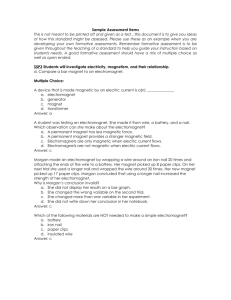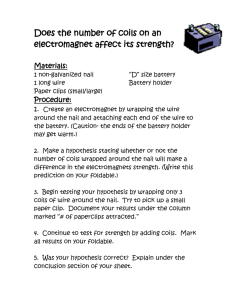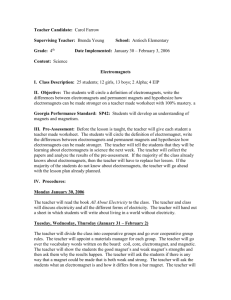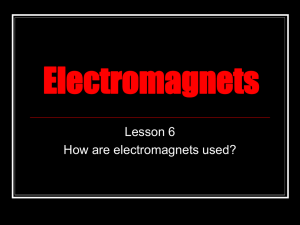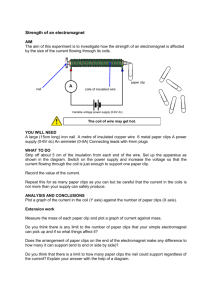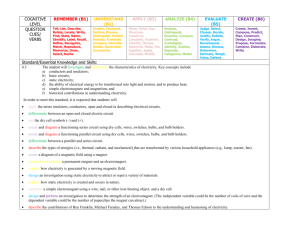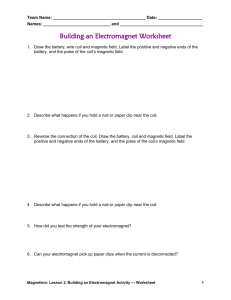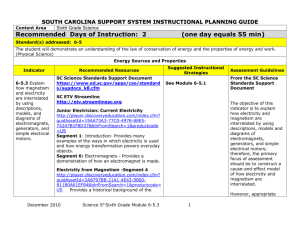Electromagnets - Ebookscard.org
advertisement
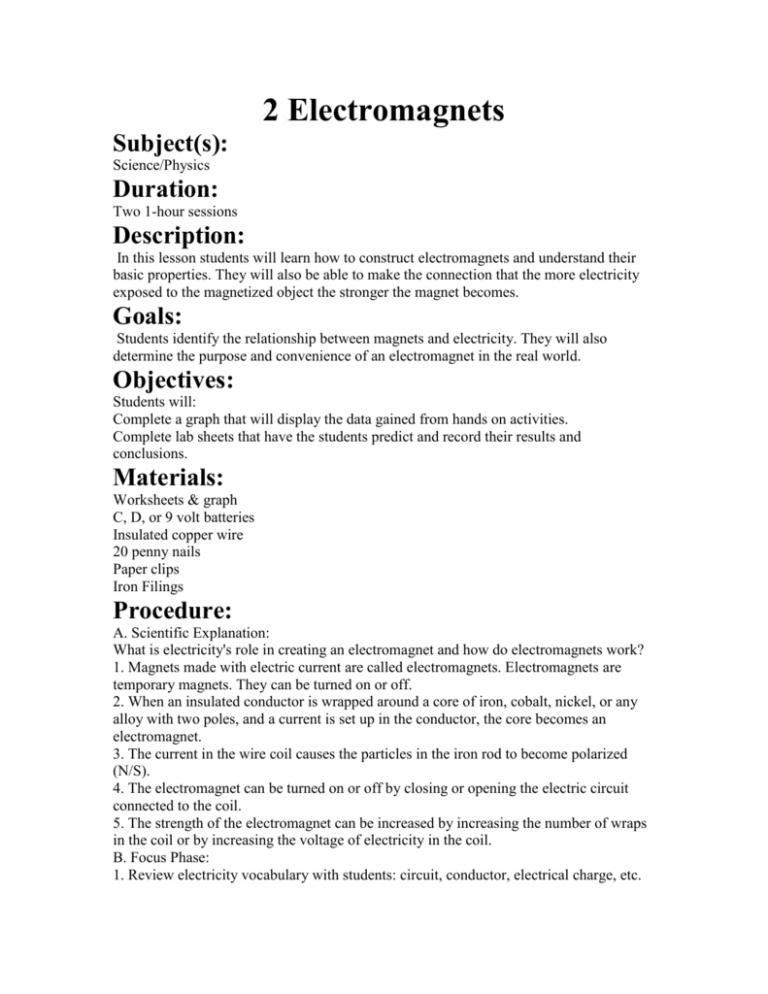
2 Electromagnets Subject(s): Science/Physics Duration: Two 1-hour sessions Description: In this lesson students will learn how to construct electromagnets and understand their basic properties. They will also be able to make the connection that the more electricity exposed to the magnetized object the stronger the magnet becomes. Goals: Students identify the relationship between magnets and electricity. They will also determine the purpose and convenience of an electromagnet in the real world. Objectives: Students will: Complete a graph that will display the data gained from hands on activities. Complete lab sheets that have the students predict and record their results and conclusions. Materials: Worksheets & graph C, D, or 9 volt batteries Insulated copper wire 20 penny nails Paper clips Iron Filings Procedure: A. Scientific Explanation: What is electricity's role in creating an electromagnet and how do electromagnets work? 1. Magnets made with electric current are called electromagnets. Electromagnets are temporary magnets. They can be turned on or off. 2. When an insulated conductor is wrapped around a core of iron, cobalt, nickel, or any alloy with two poles, and a current is set up in the conductor, the core becomes an electromagnet. 3. The current in the wire coil causes the particles in the iron rod to become polarized (N/S). 4. The electromagnet can be turned on or off by closing or opening the electric circuit connected to the coil. 5. The strength of the electromagnet can be increased by increasing the number of wraps in the coil or by increasing the voltage of electricity in the coil. B. Focus Phase: 1. Review electricity vocabulary with students: circuit, conductor, electrical charge, etc. 2. Students will be asked to write down five things that they know about magnetism. Then they will share what they wrote with their cooperating group. Finally, the groups will be asked to share with the class what they discussed in their cooperating groups. 3. Then ask the students if they think there is a relationship between magnetism and electricity. If so, what is it? Why or why not? (Pre-lesson Worksheet) B. Challenge Phase: 1. Students will be given the materials (nail, wire, and battery) to make their electromagnets. They will construct the electromagnets within their groups. 2. Have the students wind the wire around the nail leaving room at each end. Then have them make a closed circuit by attaching the free ends of the wire to the battery. 3. Then have the students test their electromagnet by sticking the nail into a pile of paper clips. 4. Ask students what the electric current did to the nail? (Made it a magnet.) 5. Ask students what happens to the nail when the electric current is shut off? (The nail looses its magnetism.) C. Concept Introduction Phase: Reinforcer Use Lab Worksheet 1. Terms and concepts students should be aware of: magnetic field, poles (N/S), opposites attract, likes repel, atoms that make magnets have certain numbers of electrons arranged in certain ways (demonstration of atom use p.306 in the Glencoe text book). 2. To teach the idea that magnets have polar properties, use the following demonstration: place a piece of paper over the magnet then sprinkle the iron filings over the paper. Have the students observe the design made by the filings on the paper. The filings should represent the magnetic field. 3. Do the number of coils around the nail affect the strength of the electromagnet? Ask the students what might be done to the nail to make it a stronger magnet? 4. Have each group design a fair test to examine this question. Have them consider: Will the wires be wrapped around the nail side by side or on top of each other? Will the wires be wrapped around the entire length of the nail or just at its head or tip? Will the wires be tightly or loosely wrapped around the nail? 5. Have the students complete at least two trials. One trial could include wrapping 10 coils around the nail and in the second trial the students could wrap 60 coils around the nail. Which trial produced a stronger electromagnet? 6. Then have students plot a line graph, which shows the relationship between the number of coils and the strength of the electromagnet. The number of paper clips the magnet picks up will determine the strength. (Sample attached) 7. Ask students what they can conclude about the data? The more coils the stronger the electromagnet. What other factors might affect the strength of the electromagnet? (Voltage of power source, size of core, presence or absence of a core, type of core, etc.) 8. Have students discuss situations where moving things with electromagnets might be useful. What are the advantages in moving things with electromagnets rather than a permanent magnet? (Picking up cars at a wrecking yard.) 9. Where else in our world do we use electromagnets? Show Superman Roller Coaster video. It demonstrates a practical application of electromagnets. D. Concept Application: 1. Students will be asked to complete a worksheet, which will check for understanding. (Lab Worksheet and Graph Worksheet). Assessment: A. Participation: B. Graph and worksheet: (grading was based on thoughtful predictions, participation, and writing out the graph and conclusions) References: Barr, B. (1998). Children and science. Cortland, NY: Deerwood Publishing. (p. 171-174). Butler, L. e.g. (1999). Glencoe science; an introduction to the life, earth, and physical science. New York, NY: Glencoe McGraw-Hill. (p. 357-365). Worksheet 1 (pre lesson) Name: ______________________Date:_________ 1.) Write five things you know about magnets. 2.) What is the relationship between magnets and electricity? Worksheet 2 (lab sheet) Name: ______________________Date:_________ Prediction: Results: Conclusion: Describe what happens to the atoms when something becomes magnetized. Look Back at what you said about magnetism and electricity – how has that changed? Graph Worksheet Electromagnetic Strength Name:__________ 50 45 # of 40 Paper Clips 35 30 25 20 15 10 5 0 5 10 15 20 25 30 # Wraps (these are the numbers that we used for graphing and had an excel printout of this graph. The number of wraps on the nail increase by five and the number of paperclips increases by five.)
